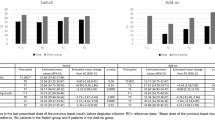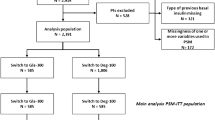Abstract
Introduction
The aim was to compare clinical outcomes by different dosing frequencies of insulin detemir (detemir) used over 52 weeks in various regimens. Methods: This analysis involved French patients enrolled in PREDICTIVE (a large-scale, multinational, observational study of empirical use of detemir in everyday clinical practice) for whom data have been collected over 52 weeks. Three cohorts were considered: patients with type 1 diabetes; patients with type 2 diabetes using detemir in a basal insulin plus oral antidiabetic drug (OAD) regimen; patients with type 2 diabetes using detemir as part of basal-bolus insulin therapy. In each cohort, data were stratified according to detemir dosing frequency at the beginning and end of 52 weeks: once daily (o.d.) at the beginning and end; twice daily (b.i.d.) at the beginning and end; o.d. at the beginning, but b.i.d. at the end. Endpoints assessed included glycated hemoglobin, fasting plasma glucose, hypoglycemia, weight, and insulin dose.
Results
There were improvements in glycemic control and tolerability in all subgroups. Patients completing on o.d. dosing tended to have better outcomes than those completing on b.i.d. dosing in all cohorts, and o.d. administration was associated with lower insulin dosing. There was little evidence that switching from o.d. to b.i.d. dosing influenced outcomes other than insulin dose. However, there were some baseline differences between subgroups selected for o.d. and b.i.d. dosing that might have influenced outcomes: many patients appeared to have been continued on previous basal dosing frequencies; for others, b.i.d. detemir dosing seemed to be used to intensify previous therapy.
Conclusions
With the caveat that empirical choices of dose frequency were made, this analy-sis shows that empirical use of o.d. detemir produces results at least as good as empirical use of b.i.d. detemir in basal-bolus-treated type 1 and type 2 diabetes, and in basal plus OAD-treated type 2 diabetes.
Similar content being viewed by others
References
Havelund S, Plum A, Ribel U, et al. The mechanism of protraction of insulin detemir, a long-acting, acylated analog of human insulin. Pharm Res. 2004;21:1498–1504.
Plank J, Bodenlenz M, Sinner F, et al. A double-blind, randomised, dose-response study investigating the pharmacodynamic and pharmacokinetic properties of the long-acting insulin analog detemir. Diabetes Care. 2005;28:1107–1112.
Heise T, Nosek L, Rønn BB, et al. Lower within-subject variability of insulin detemir in comparison to NPH insulin and insulin glargine in people with type 1 diabetes. Diabetes. 2004;53:1614–1620.
Wutte A, Plank J, Bodenlenz M, et al. Proportional dose-response relationship and lower within-patient variability of insulin detemir and NPH insulin in subjects with type 1 diabetes mellitus. Exp Clin Endocrinol Diabetes. 2007;115:461–467.
Klein O, Lynge J, Endahl L, et al. Albumin-bound basal insulin analogs (insulin detemir and NN344): comparable time-action profiles but less variability than insulin glargine in type 2 diabetes. Diabetes Obes Metab. 2007;9:290–299.
Home P, Kurtzhals P. Insulin detemir: from concept to clinical experience. Expert Opin Pharmacother. 2006;7:325–343.
Bartley PC, Bogoev M, Larsen J, et al. Long-term efficacy and safety of insulin detemir compared to neutral protamine Hagedorn insulin in patients with type 1 diabetes using a treat-to-target basalbolus regimen with insulin aspart at meals: a 2-year, randomised, controlled trial. Diabet Med. 2008;25:442–449.
Heise T, Pieber TR. Towards peakless, reproducible and long-acting insulins. An assessment of the basal analogs based on isoglycemic clamp studies. Diabetes Obes Metab. 2007;9:648–659.
Philis-Tsimikas A, Charpentier G, Clauson P, et al. Comparison of once-daily insulin detemir with NPH insulin added to a regimen of oral antidiabetic drugs in poorly controlled type 2 diabetes. Clin Ther. 2006;28:1569–1581.
Le Floch J-P, Lévy M, Mosnier-Pudar H, et al. Comparison of once- versus twice-daily administration of insulin detemir, used with mealtime insulin aspart, in basal-bolus therapy for type 1 diabetes: assessment of detemir administration in a progressive treat-to-target trial (ADAPT). Diabetes Care. 2009;32:32–37.
Dornhorst A, Lüddeke HJ, Sreenan S, et al. Safety and efficacy of insulin detemir in clinical practice: 14-week follow-up data from type 1 and type 2 diabetes patients in the PREDICTIVE European cohort. Int J Clin Pract. 2007;61:523–528.
DeVries JH, Nattrass M, Pieber TR. Refining basal insulin therapy: what have we learned in the age of analogs? Diabetes Metab Res Rev. 2007;23:441–454.
Lüddeke HJ, Sreenan S, Aczel S, et al. PREDICTIVE Study Group. PREDICTIVE — a global, prospective observational study to evaluate insulin detemir treatment in types 1 and 2 diabetes: baseline characteristics and predictors of hypoglycaemia from the European cohort. Diabetes Obes Metab. 2007;9:428–434.
Meneghini LF, Rosenberg KH, Koenen C, et al. Insulin detemir improves glycaemic control with less hypoglycaemia and no weight gain in patients with type 2 diabetes who were insulin naive or treated with NPH or insulin glargine: clinical practice experience from a German subgroup of the PREDICTIVE study. Diabetes Obes Metab. 2007;9:418–427.
Dornhorst A, Lüddeke HJ, Koenen C, et al. Transferring to insulin detemir from NPH insulin or insulin glargine in type 2 diabetes patients on basalonly therapy with oral antidiabetic drugs improves glycaemic control and reduces weight gain and risk of hypoglycaemia: 14-week follow-up data from PREDICTIVE. Diabetes Obes Metab. 2008;10:75–81.
Dornhorst A, Lüddeke HJ, Sreenan S, et al. Insulin detemir improves glycaemic control without weight gain in insulin-naïve patients with type 2 diabetes: subgroup analysis from the PREDICTIVE study. Int J Clin Pract. 2008;62:659–665.
Honka M. Results of the PREDICTIVE project in the Czech Republic [in Czech]. Vnitr Lek. 2008;54:361–367.
Holman RR, Thorne KI, Farmer AJ, et al. 4-T Study Group. Addition of biphasic, prandial, or basal insulin to oral therapy in type 2 diabetes. N Engl J Med. 2007;357:1716–1730.
Author information
Authors and Affiliations
Corresponding author
Rights and permissions
About this article
Cite this article
Fontaine, P., Gin, H., Pinget, M. et al. Effect of insulin detemir dose frequency on clinical outcomes in patients with diabetes in PREDICTIVE. Adv Therapy 26, 535–551 (2009). https://doi.org/10.1007/s12325-009-0033-6
Received:
Published:
Issue Date:
DOI: https://doi.org/10.1007/s12325-009-0033-6




